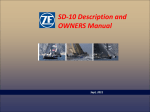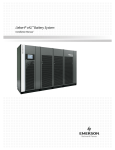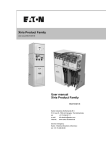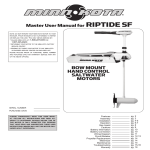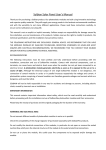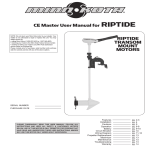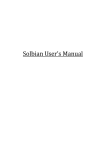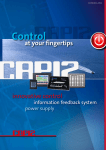Download ShIP Installation Manual
Transcript
User’s Manual For the SHORE POWER CONNECTION MONITOR MODEL 9151 Table of Contents: Product Description .................................................................................................... 3 Installation................................................................................................................... 4 Optional Remote Alarm Installation........................................................................... 7 Operator Test .............................................................................................................. 8 Alarms......................................................................................................................... 9 Figures....................................................................................................................... 10 Shurite Marine Systems Telephone (203) 481-5721 • Facsimile (203) 481-8937 • [email protected] www.primetechnology.com 2 Product Description The shore power connection monitor or ShIP constantly monitors the temperature of the on-board shore power inlet contacts and the wiring to it. When an overheated condition is detected the monitor will disconnect power to the vessel from shore power and sound an audible alarm to notify ships personnel. Ship’s personnel can then determine what action to take to prevent further damage to the vessel. The shore power connection monitor provides the following features: • The temperature monitor periodically performs a self-test and advances the green TEMPERATURE SCANNING LEDs to notify personnel the unit is operating correctly. • A green SHORE POWER LED indicates shore power is present. • A red REVERSE POLARITY LED indicates a reverse polarity input power connection. • A yellow OVER TEMPERATURE LED indicates an over temperature condition exists on the shore power connection. • The audible alarm can be manually silenced from the front panel. • A remote alarm connection with a single set of normally open and normally closed contacts. • If an overheated condition occurs, the audible alarm will sound for a maximum of five (5) minutes and then turn off to avoid a prolonged disturbance to neighboring vessels. The red ALARM TRIPPED LED will remain on until the user actively resets the unit. • Depressing the TEST push button will perform a built in test which will simulate an over temperature condition and trip the circuit breaker. Shurite Marine Systems Telephone (203) 481-5721 • Facsimile (203) 481-8937 • [email protected] www.primetechnology.com 3 Installation Warning – Hazardous voltages may be present, a licensed electrician should perform the shore power connection monitor installation. ________________________________________________________________________ 1. Disconnect all shore power from the vessel and turn off all on board generators. 2. Determine the location for mounting the enclosure. This location must be on a vertical wall. This device has not been approved as an ignition protection device. It must not be located in an area where flammable fuels are present. See ABYC E-11 AC and DC Electrical Systems on Boats section 11.5.1.3 for recommended spaces. The enclosure should be mounted between the shore power inlet connector and the AC power distribution panel somewhere along the AC power cable path. 3. ABYC E-11 AC and DC Electrical Systems on Boats section 11.12.2.9.3. states: “ If the location of the main shore power disconnect circuit breaker is in excess of 10 feet (three meters) from the shore power inlet or the electrical attachment point of a permanently installed shore power cord, additional fuses or circuit breakers shall be provided within 10 feet (three meters) of the inlet or attachment point to the electrical system of the boat. Measurement is made along the conductors.” Mounting the ShIP enclosure within 10’ of the inlet connector will satisfy this requirement. 4. The enclosure has two internal terminal blocks for the AC power cable, spaced five (5) inches apart (See figure 1). This will allow the installer to cut the existing AC power cable, strip the cable wires, and connect the enclosure in series with the cut cable. Installing the enclosure in this manner will eliminate the time and expense of running a new AC power cable from either the shore power inlet connector and the enclosure, or the AC power distribution panel and the enclosure. If this is physically not possible, the installer must make a decision whether it is more economical to run a new AC power cable from the enclosure to the AC distribution panel or to the shore power inlet connector. 5. Remove the four plastic screws from the monitor enclosure and carefully lift off the front panel. (See figure 1) There are three signal connectors that can be removed from the printed circuit board by squeezing the locking tabs on the Shurite Marine Systems Telephone (203) 481-5721 • Facsimile (203) 481-8937 • [email protected] www.primetechnology.com 4 connector and pulling on the connector. During installation, it is not necessary to completely detach the front panel by disconnecting the power wires, provided caution is used so as not to apply unnecessary pressure on it. 6. Included in the Hardware Kit are two types of cable glands, one for a round AC power cable and one for a rectangular AC power cable. Determine which type of AC power cable is used on the vessel and install one on the left hand side of the enclosure and one on the right. There are two different size locknuts also supplied in the Hardware Kit, use the locking nuts to securely fasten the cable glands to the enclosure. 7. Install the ShIP enclosure on a vertical bulkhead. Fasten the box using four screws in the corner holes (See black arrows in Fig. 1) under the front panel screws to prevent the box from coming off the bulkhead while under way. 8. The ShIP receives power from the shore power connection made to the marina. The ShIP enclosure may be mounted on either the port or starboard side of the vessel; either forward or aft of the shore power inlet connector. The power cable from the shore power inlet connector may enter either on the left side or right side of the enclosure. It is important to connect the ShIP internal AC wiring to the proper terminal block (left or right) to maintain power to the ShIP if the circuit breaker is tripped. The ShIP comes pre-wired from the factory for a right hand power entry. That is, the power from the shore enters the right hand side of the enclosure. In the case where the power enters the left hand side the installer must remove the black wire on the right hand terminal block labeled LINE and remove the black wire on the left hand terminal block labeled LOAD. Then connect the black wire labeled LINE to the left hand terminal block and connect the black wire labeled LOAD to the right hand terminal block. 9. Route the AC power cable through the cable clamp on the left hand side of the enclosure to the left hand terminal block and connect the hot black wire to the open terminal block connection across from the black wire, neutral white wire to the open terminal block connection across from the white wire, and ground green wire green to the open terminal block connection across from the green wire. Route the AC power cable through the cable clamp on the right hand side of the enclosure to the right hand terminal block and connect the wires to the open terminal block connections as above. Tighten both cable gland-clamping nuts to strain relief the AC power cables on both sides on the enclosure. Make sure all screws on the terminal blocks are tight. Shurite Marine Systems Telephone (203) 481-5721 • Facsimile (203) 481-8937 • [email protected] www.primetechnology.com 5 10. Clean out any strands of wire remaining in the enclosure after installing wires. 11. Locate and remove the shore power inlet connector and disconnect the existing vessel’s AC power cable from the inlet connector. Inspect the shore power inlet connector for signs of corrosion, melted plastic, or discolored terminals caused by overheating. Replace the inlet connector if it has been damaged. Inspect the wires of the vessel’s AC power cable for signs of melted insulation or discolored wire due to overheating. The wires may have to be cut back and stripped or replaced before proceeding. 12. Position one of the sensors 3/8” from the stripped edge of the hot black wire of the AC cable (see figure 2) and hold it there. Slide the shrink tubing supplied in the Hardware Kit over the sensor and the wire. Use a heat gun to shrink the tubing evenly over the sensor and wire (see figure 3). The sensor assembly should be firmly fastened to the wire. Use a tywrap to secure the wires of the sensor to the wire to prevent breaking the sensor wires while handling the AC wires. 13. Repeat the previous step for the neutral white wire of the AC cable using the other sensor. 14. Reconnect the wires to the shore power inlet connector; hot black wire to black terminal, neutral white wire to white terminal, and ground green wire to green terminal. Reinstall the shore power inlet connector. 15. Route the other end of the sensor signal cable to the ShIP enclosure location. Feed the sensor cable through the small cable clamp on the left hand side of the enclosure. Cut the sensor cable 2” to 3” longer than it takes to reach J2 on the PCB (shown by the white arrow in figure 1). Strip the ends of the red and black pair and insert them into J2 positions 1 and 2 and tighten the screws; polarity doesn’t matter. Strip the ends of the white and black pair and insert them into J2 positions 3 and 4 and tighten the screws. 16. Clean out any strands of wire remaining in the enclosure after installing wires. 17. Reconnect the three front panel signal connectors to the printed circuit board, replace the front cover and tighten the four plastic screws. 18. Reconnect the shore power to the vessel. On the shore power monitor front panel the green shore power LED should be on and the green temperature scanning LEDs in the shape of a wave should sequentially turn on. (If the green shore power LED is not on, disconnect the shore power and check the connections made in the previous steps.) 19. This concludes the installation. Shurite Marine Systems Telephone (203) 481-5721 • Facsimile (203) 481-8937 • [email protected] www.primetechnology.com 6 Optional Remote Alarm Installation The ShIP 110 provides a normally open and normally closed relay contact for an isolated remote alarm feature. These contacts are rated for 115 VAC at 10 Amps. The installer needs only to wire in the remote alarm to either J5-1 & J5-2 for a normally closed alarm or J5-1 & J5-3 for a normally open alarm. The ShIP will energize the remote alarm relay changing the condition of the contact closures for an alarm condition. Note: Hardware is provided for an alarm cable diameter between 0.20” to 0.32”. If the remote alarm cable is of a different size the installer must provide a suitable water resistant cable gland otherwise the warrantee will be void. Warning – Hazardous voltages may be present, a licensed electrician should perform the shore power connection remote alarm installation. ________________________________________________________________________ 1. Disconnect all shore power from the vessel and turn off all on board generators. 2. Drill an 11/16” hole on the right hand side of the enclosure using figure 4 as a guide. 3. Install the 3/8” cable gland and locking nut provided in the Hardware Kit. This cable gland will accept and seal a 0.20” to 0.32” diameter cable. 4. Feed the remote alarm cable through the cable gland and cut the sensor cable 2 to 3” longer than it takes to reach J5 on the printed circuit board. Strip the ends of the remote alarm cable and insert them into J5 positions 1 and 2 for a normally closed alarm or J5-1 & J5-3 for a normally open alarm and tighten the screws. 5. Clean out any strands of wire remaining in the enclosure after installing wires. 6. Tighten the cable gland-clamping nut to strain relief the remote alarm cable. 7. Reconnect the shore power to the vessel. 8. Perform the Operator Test described in the next section to test the remote alarm. Shurite Marine Systems Telephone (203) 481-5721 • Facsimile (203) 481-8937 • [email protected] www.primetechnology.com 7 Operator Test Warning – To prevent damage to air conditioning compressors and other equipment the operator should wait a few minutes before turning the breaker back on. Read the air conditioner users manual for recommended times. ________________________________________________________________________ A simple test can be performed to check for proper operation of the monitor. The operator should press and hold the TEST push button for at least 2 seconds. The circuit breaker will trip, and the audible alarm and the red ALARM TRIPPED LED will stay on as long as the push button is depressed. Releasing the push button will turn off the audible alarm and the green TEMPERATURE SCANNING LEDs will resume scanning indicating the monitor has resumed checking for an over temperature condition. The operator must manually reset the circuit breaker. Shurite Marine Systems Telephone (203) 481-5721 • Facsimile (203) 481-8937 • [email protected] www.primetechnology.com 8 Alarms If an actual alarm occurs or upon returning to the vessel the monitor is in an alarm condition, the red ALARM TRIPPED LED is on and the main switch is tripped, the following steps are recommended: 1. MUTE the audible alarm (if necessary), depress and hold the mute button for at least 2 seconds. 2. Turn off the shore power at the dock and check the following: • Check the shore power inlet connector for corrosion and loose connections and repair if necessary. • Check the shore power connector from the marina for corrosion and loose connections, and repair if necessary. • If the yellow OVER TEMPERATURE LED is still on, the inlet connector is too hot and must be allowed to cool before the alarm can be cleared. • After the problem is corrected depress and hold the ALARM CLEAR push button for at least 2 seconds, and manually reset the circuit breaker. If only the red ALARM TRIPPED LED is on and the scanning LEDs are not scanning the monitor has detected a circuit problem and must be serviced to ensure proper operation. It could be one of the following. • Sensor cable open • Sensor cable short • Circuit failure on the PCB If only the main switch is tripped there is an overload condition somewhere on the vessel. Shurite Marine Systems Telephone (203) 481-5721 • Facsimile (203) 481-8937 • [email protected] www.primetechnology.com 9 Figures Figure 1 Shore power connector monitor box with front panel removed. Shurite Marine Systems Telephone (203) 481-5721 • Facsimile (203) 481-8937 • [email protected] www.primetechnology.com 10 Figure 2 Temperature Sensor Assembly Thermistor Tywrap Current Carrying C d t 3/8 " Shrink Tubing Figure 3 Shurite Marine Systems Telephone (203) 481-5721 • Facsimile (203) 481-8937 • [email protected] www.primetechnology.com 11 Figure 4 Drill a hole on the right hand side of the enclosure for the Remote Alarm cable gland. 2.25" 1.125" .6875" For claims under warranty please call (203) 481-5721. Shurite Marine Systems Telephone (203) 481-5721 • Facsimile (203) 481-8937 • [email protected] www.primetechnology.com 12













